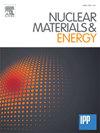Thermal analysis of the W/Cu flat-type component used as lower divertor target in EAST
IF 2.7
2区 物理与天体物理
Q1 NUCLEAR SCIENCE & TECHNOLOGY
引用次数: 0
Abstract
The tungsten-copper (W/Cu) flat-type component is a promising candidate for plasma-facing components, praised for its flexible heat sink design and cost-effective fabrication. It is considered for the ITER divertor dome section and holds potential for divertor targets for future fusion devices. Since 2021, three types of ITER-like W/Cu flat-type components with chamfer angles of 2.40°, 3.76°, and 5.19° have been installed and tested on the outer horizontal target of the lower divertor in EAST. During plasma operations, some W/Cu flat-type components experienced cracking, melting and exfoliation of tungsten, causing plasma disruptions and even the termination of experiments. To address this, this study uses Fluent to evaluate the melting thresholds of these components based on simulations that consider actual conditions. The key findings are summarized: Firstly, only certain W plates can reach high temperatures because the in-situ heat flux is localized, explaining why damage often occurs only on some specific plates. During leading-edge events, the highest temperatures for both W and oxygen-free copper (OFC) occur near the sides, but W’s maximum temperature is at the edge, while OFC’s is near the edge. The high-temperature area for OFC is larger than that for W, resulting in a more uniform temperature distribution. Secondly, for components with chamfer angles of 3.76° and 5.19°, the heat flux required for OFC to melt is always lower than that for W, meaning OFC melts first. For the 2.40° chamfer, OFC melts first when the incident heat flux angle exceeds 2.5°, while W melts first below this angle. At a 10 MW total heating power, all three components face a melting risk at the maximum incident angle of 5° during EAST operations. Thirdly, a linear relationship was identified between the maximum temperatures of W and OFC under such complex loading conditions, offering a method for monitoring OFC maximum temperature based on the IR measurement of surface W temperature. Moreover, this linear relationship can be extended to other heat sink materials. These results provide valuable guidance for EAST’s plasma operations and offer reference data for the use of W/Cu flat-type components in next-generation devices like ITER and CFETR.
东油田下导流靶W/Cu平板组件热分析
钨铜(W/Cu)平板元件是等离子体表面元件的一个有前途的候选者,因其灵活的散热器设计和经济高效的制造而受到称赞。它被认为是ITER分流器圆顶部分的一部分,并有可能成为未来聚变装置的分流器目标。自2021年起,在EAST下部导流器外水平靶上安装了三种倒角分别为2.40°、3.76°和5.19°的类似iter的W/Cu平板式组件并进行了测试。在等离子体操作过程中,一些W/Cu平板型元件发生钨的开裂、熔化和剥落,导致等离子体中断,甚至实验终止。为了解决这个问题,本研究在考虑实际条件的模拟基础上,使用Fluent来评估这些组件的熔化阈值。主要发现如下:首先,由于原位热流是局部化的,只有某些W板可以达到高温,这解释了为什么损伤往往只发生在某些特定的板上。在前缘事件中,W和无氧铜(OFC)的最高温度都出现在边缘附近,但W的最高温度在边缘,而OFC的最高温度在边缘附近。OFC的高温面积大于W,温度分布更加均匀。其次,对于倒角为3.76°和5.19°的构件,OFC熔化所需的热流密度q0始终小于W,即OFC先熔化。对于2.40°倒角,当入射热流密度角超过2.5°时,OFC首先熔化,而W在此角以下首先熔化。在总加热功率为10兆瓦的情况下,在EAST运行期间,所有三个组件在最大入射角为5°时都面临熔化风险。第三,在这种复杂载荷条件下,确定了W的最高温度与OFC之间的线性关系,为基于红外测量表面W温度的OFC最高温度监测提供了一种方法。此外,这种线性关系可以推广到其他散热器材料。这些结果为EAST的等离子体操作提供了有价值的指导,并为在ITER和CFETR等下一代装置中使用W/Cu平面型元件提供了参考数据。
本文章由计算机程序翻译,如有差异,请以英文原文为准。
求助全文
约1分钟内获得全文
求助全文
来源期刊

Nuclear Materials and Energy
Materials Science-Materials Science (miscellaneous)
CiteScore
3.70
自引率
15.40%
发文量
175
审稿时长
20 weeks
期刊介绍:
The open-access journal Nuclear Materials and Energy is devoted to the growing field of research for material application in the production of nuclear energy. Nuclear Materials and Energy publishes original research articles of up to 6 pages in length.
 求助内容:
求助内容: 应助结果提醒方式:
应助结果提醒方式:


